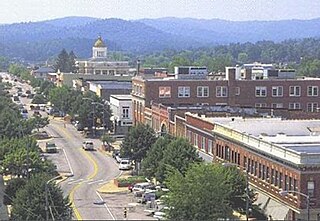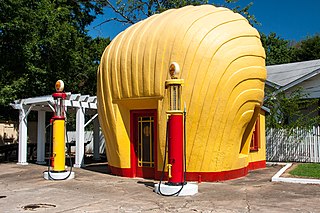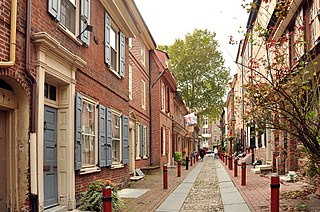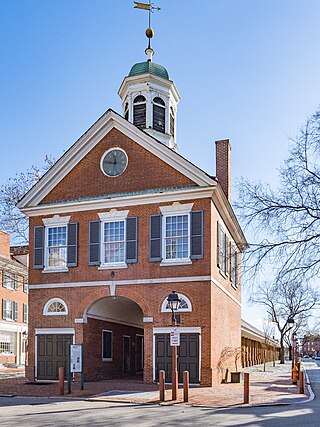
Hendersonville is a city in and the county seat of Henderson County, North Carolina, United States, located 22 miles (35 km) south of Asheville. Like the county, the city is named for 19th-century North Carolina Supreme Court Chief Justice Leonard Henderson.

Albemarle is a city in and the county seat of Stanly County, North Carolina, United States. The population was 16,432 in the 2020 census.

This is a list of structures, sites, districts, and objects on the National Register of Historic Places in North Carolina:

This is intended to be a complete list of properties and districts listed on the National Register of Historic Places in Orleans County, New York. The locations of National Register properties and districts may be seen in a map by clicking on "Map of all coordinates". Two listings, the New York State Barge Canal and the Cobblestone Historic District, are further designated a National Historic Landmark.

The Shell Service Station in Winston-Salem, North Carolina, is a former filling station constructed in 1930 following a decision in the 1920s by the new local Shell distributor, Quality Oil Company, to bring brand awareness to the market in Winston-Salem. The building is an example of representational or novelty architecture and was listed on the National Register of Historic Places on May 13, 1976. It is located in the Waughtown-Belview Historic District at the corner of Sprague and Peachtree Streets.

Historic districts in the United States are designated historic districts recognizing a group of buildings, archaeological resources, or other properties as historically or architecturally significant. Buildings, structures, objects, and sites within a historic district are normally divided into two categories, contributing and non-contributing. Districts vary greatly in size and composition: a historic district could comprise an entire neighborhood with hundreds of buildings, or a smaller area with just one or a few resources.

In the law regulating historic districts in the United States, a contributing property or contributing resource is any building, object, or structure which adds to the historical integrity or architectural qualities that make the historic district significant. Government agencies, at the state, national, and local level in the United States, have differing definitions of what constitutes a contributing property but there are common characteristics. Local laws often regulate the changes that can be made to contributing structures within designated historic districts. The first local ordinances dealing with the alteration of buildings within historic districts was enacted in Charleston, South Carolina in 1931.

College Hill is a neighborhood in the west central section of the United States city of Greensboro, North Carolina. College Hill was Greensboro's first neighborhood.

New Market, as it was originally known, and later also known as Head HouseMarket and Second Street Market, is an historic street market which is located on South 2nd Street between Pine and Lombard Streets in the Society Hill neighborhood of Philadelphia, Pennsylvania. With a history dating to 1745, it is one of the oldest surviving market buildings of its type in the nation.

The Moore Square Historic District is a registered historic district located in downtown Raleigh, North Carolina. Listed on the National Register of Historic Places in 1983, the district is centered on Moore Square, one of two surviving four-acre parks from Raleigh's original 1792 plan. The park is named after Alfred Moore, a North Carolina judge who became an Associate Justice on the Supreme Court. Originally a residential neighborhood, Moore Square developed into a primary commercial hub in the city throughout the late 19th and early 20th centuries. The district includes East Hargett Street, once known as Raleigh's "Black Main Street", because it once contained the largest number of businesses owned by African-Americans in the city. City Market, Marbles Kids Museum/IMAX theatre, Pope House Museum, Artspace, and the Long View Center are located in the Moore Square district. Events that take place in Moore Square include the Raleigh Arts Festival, Artsplosure, Movies in the Park, the Street Painting Festival, and the Moore Square Farmer's Market The approximate district boundaries include Person, Morgan, Wilmington, and Davie Streets.

William Lee Stoddart (1868–1940) was an architect who designed urban hotels in the Eastern United States. Although he was born in Tenafly, New Jersey, most of his commissions were in the South. He maintained offices in Atlanta and New York City.

There are 77 properties listed on the National Register of Historic Places in Albany, New York, United States. Six are additionally designated as National Historic Landmarks (NHLs), the most of any city in the state after New York City. Another 14 are historic districts, for which 20 of the listings are also contributing properties. Two properties, both buildings, that had been listed in the past but have since been demolished have been delisted; one building that is also no longer extant remains listed.

This list includes properties and districts listed on the National Register of Historic Places in Washington County, North Carolina. Click the "Map of all coordinates" link to the right to view a Google map of all properties and districts with latitude and longitude coordinates in the table below.

Prospect House is a historic building, located at 3508 Prospect Street, Northwest, Washington, D.C., in the Georgetown neighborhood.

Downtown Johnstown Historic District is a national historic district located at Johnstown in Cambria County, Pennsylvania. The district includes 109 contributing buildings, 4 contributing sites, and 1 contributing structure in the central business district and surrounding residential areas of Johnstown. The district includes some buildings dated before the Johnstown Flood, but the majority date from 1890 to 1930. Notable buildings include the Alma Hall (1884), Bantley Building (1888), Stenger Dry Goods Store (1883), Widmann Building (1892), Cambria Iron Office Building, St. Vincent DePaul Building, Swank Building (1907), Glosser Brothers Department Store (1905), Johnstown City Hall (1900), former U.S. Post Office (1912), State Theater (1926), U.S. Post Office (1938), Franklin Street United Methodist Church (1869), St. John Gualbert Cathedral (1896), First United Methodist Church (1911), Elks Building (1903), and Moose Building (1917). Located in the district and listed separately are the Cambria Public Library Building, G.A.R. Hall, and Nathan's Department Store.
Louis H. Asbury (1877–1975) was an American architect, a leading architect of Charlotte, North Carolina. He is asserted to be the "first professionally trained, fulltime architect in North Carolina who was born and practiced in the state."

Halifax Historic District is a national historic district located at Halifax, Halifax County, North Carolina, US that was listed on the National Register of Historic Places in 1970. It includes several buildings that are individually listed on the National Register. Halifax was the site of the signing of the Halifax Resolves on April 12, 1776, a set of resolutions of the North Carolina Provincial Congress which led to the United States Declaration of Independence gaining the support of North Carolina's delegates to the Second Continental Congress in that year.
Dougherty Heights Historic District is a national historic district located at Black Mountain, Buncombe County, North Carolina. The district encompasses 54 contributing buildings in a predominantly residential section of Black Mountain. The district includes a variety of early-20th century dwellings in the Colonial Revival, American Craftsman, and Queen Anne styles. The district is characterized by a mix of primarily one- and two-story frame houses on small lots.

Washington Street Historic District is a national historic district located at High Point, Guilford County, North Carolina. The district encompasses 36 contributing buildings and 1 contributing structure in a predominantly African-American section of High Point. They date from the early- to mid-20th century and include a mix of commercial and residential buildings in a variety of popular architectural styles including Art Moderne, Classical Revival architecture, Colonial Revival architecture, Gothic Revival architecture, and Bungalow / American Craftsman architecture. Located in the district and listed separately are the Kilby Hotel, First Baptist Church, and William Penn High School. Other notable buildings include the Odd Fellows Hall, Morgan Apartments, Hoover's Funeral Home, the Toussaint L’Ouverture Lodge No. 524, Yarborough Law Building and the Washington Street Branch of the High Point Public Library.

Washington Street–Monument Circle Historic District is a national historic district located at Indianapolis, Indiana, United States, covering the first two blocks of East and West Washington and Market streets, the south side of the 100 block of East Ohio Street, Monument Circle, the first block of North and South Meridian Street, the first two blocks of North Pennsylvania Street, the west side of the first two blocks of North Delaware Street, the east side of the first block of North Capitol Avenue, and the first block of North Illinois Street. In total, the district encompasses 40 contributing buildings and 2 contributing structures in the central business district of Indianapolis centered on Monument Circle. It developed between about 1852 and 1946, and includes representative examples of Italianate, Greek Revival, and Art Deco style architecture.






















